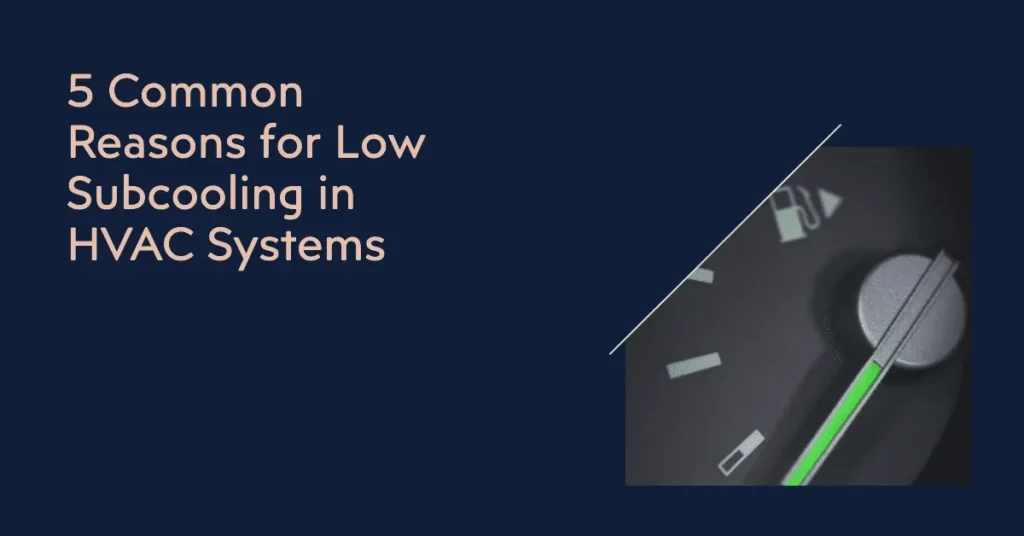Subcooling and Its Role
Table of Contents
Toggle
The process of subcooling involves cooling the refrigerant to a temperature at its saturation point effectively removing heat. This additional cooling is important for keeping the refrigerant in its form and preventing the formation of vapor bubbles that can disrupt the HVAC system’s functioning. Subcooling plays a role in maintaining cooling and maximizing energy efficiency.
Ideal Subcooling Levels
The ideal levels of subcooling can vary depending on factors like the type of HVAC system and the specific refrigerant being used. However, industry standards and expert recommendations provide some guidelines;
For systems with an expansion valve (TXV), the recommended range for subcooling levels is typically between 10°F to 18°F.
Certain systems may require subcooling readings of up to 16°F to achieve efficiency and capacity.
It is essential to consult the equipment manufacturers’ specifications and adhere to HVAC industry standards for obtaining the recommended subcooling levels specific, to your system.
Maintaining subcooling is critical as it ensures that the refrigerant remains ready to absorb heat within the evaporator coil. This contributes to cooling while minimizing compressor damage risks.
What Causes Low Subcooling (5 Common Reasons)

Insufficient Refrigerant Charge
The HVAC system can’t properly absorb and release heat when there’s not enough refrigerant. This leads to low subcooling.
Causes: Leaks, improper installation, or gradual loss over time.
Refrigerant Leaks
Leaks allow refrigerant to escape, reducing the amount available for cooling.
Indicators: A drop in subcooling, hissing sounds, or frost on refrigerant lines.
Dirty or Blocked Condenser Coils
Dust and debris on condenser coils hinder heat dissipation, causing subcooling to drop.
Maintenance: Regular cleaning of coils can prevent this issue.
Faulty Expansion Valves
Expansion valves control refrigerant flow. If they malfunction, subcooling can be affected.
Signs: Fluctuating subcooling levels or poor system performance.
Overheating Compressor
High subcooling is vital to protect the compressor from overheating. Low subcooling can strain the compressor.
Indicators: Excessive noise, vibration, or even system shutdown.
The Effects of Low Subcooling
Reduced Cooling Efficiency
Inadequate subcooling means the refrigerant isn’t as effective in cooling, resulting in less efficient temperature control.
Increased Energy Consumption
When the system works harder to compensate for low subcooling, it consumes more energy, leading to higher bills.
Potential System Damage
Low subcooling can damage components like the compressor, reducing the system’s lifespan.
How to Detect Low Subcooling
Using a Subcooling Measurement
HVAC technicians use specialized gauges to measure subcooling. The reading should match manufacturer or industry standards.
Symptoms of Low Subcooling
Indications include poor cooling performance, longer cooling cycles, and a warmer home, which may prompt you to seek professional evaluation.
Proper subcooling is essential for efficient HVAC operation, ensuring comfort and avoiding costly repairs. Regular maintenance and professional assessments are key to preventing and addressing low subcooling issues.
Troubleshooting and Solutions
Steps to Diagnose the Cause
Diagnosing low subcooling involves inspecting refrigerant levels, checking for leaks, cleaning coils, and assessing system components like expansion valves and compressors.
Specialized gauges are used to measure subcooling, aiding in pinpointing the issue.
How to Address Low Subcooling Issues
Solutions vary based on the root cause:
- Recharge Refrigerant: If it’s low, adding refrigerant can restore proper subcooling.
- Fix Leaks: Identify and repair any leaks, then recharge the system.
- Clean Condenser Coils: Regular cleaning helps maintain efficient heat dissipation.
- Repair Faulty Components: Replace or repair expansion valves or compressors.
- Prevent Overheating: Ensure proper subcooling to avoid compressor damage.
Preventive Maintenance
Regular HVAC System Maintenance
Scheduled maintenance by professionals is crucial to prevent low subcooling.
Technicians inspect refrigerant levels, check for leaks, clean coils, and maintain system components, ensuring optimal performance.
Tips for Maintaining Proper Subcooling
Homeowners can:
- Change Filters: Regularly replace air filters to maintain airflow and reduce strain on the system.
- Clear Debris: Keep the area around the condenser unit clean to prevent airflow obstruction.
- Annual Checkups: Schedule yearly HVAC inspections to catch issues early.
- Temperature Settings: Avoid setting the thermostat too low, which can strain the system.
Regular maintenance and attention to these tips help maintain proper subcooling, ensuring efficient HVAC operation and a comfortable indoor environment.
Key Takeaways
- Low subcooling in HVAC systems can result from various issues, including insufficient refrigerant charge, refrigerant leaks, dirty condenser coils, faulty components like expansion valves, and overheating compressors. Troubleshooting these root causes and addressing them promptly is crucial.
- Solutions include recharging refrigerant, repairing leaks, cleaning condenser coils, fixing or replacing faulty components, and preventing compressor overheating. Regular maintenance and professional assessment are key to maintaining proper subcooling.



